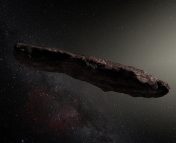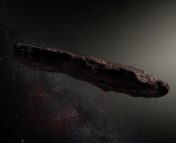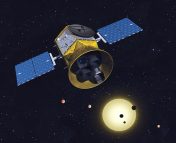Title: Initial characterization of interstellar comet 2I/Borisov
Authors: Piotr Guzik, Michał Drahus, Krzysztof Rusek, Wacław Waniak, Giacomo Cannizzaro, Inés Pastor-Marazuela
First Author Institution: Astronomical Observatory, Jagiellonian University, Kraków, Poland
Journal: arXiv (open access) / Nature (closed access)
Visitors from beyond are already here. Two years ago, the first observed interstellar asteroid, 1I/’Oumuamua, passed through our solar system. Discovered by the PanSTAARS survey, it didn’t look like anything we’d seen in our own solar system (a weird, elongated cigar shape, on a hyperbolic orbit), and some people even claimed it might be aliens scoping out our solar system. More realistically, it provided an interesting opportunity to learn about how other planetary systems formed (since it is a remnant from a distant planet’s formation), and provided our first constraint on how many of these objects we may expect to see in the future.
Flash forward in time, and we have already found a second! Enter Comet 2I/Borisov. Whereas ‘Oumuamua was a dark asteroid, Borisov is a bright trailing comet. Other than its unusual interstellar trajectory, it looks just like a comet from our solar system, as shown in Figure 1. It’s the second interstellar object we’ve seen, but the very first interstellar comet.
So, how did we find this thing? Similarly to ‘Oumuamua, the distinguishing feature that indicates it’s clearly from beyond the solar system is its strange and hyperbolic path through space. From tracking its motion in the sky, we see that it’s on a trajectory that clearly isn’t orbiting the Sun. The catch, though, is that astronomers track thousands and thousands of objects in the sky all the time (soon to be even more with the next generation of survey telescopes like LSST). Sorting through all that data manually is near impossible, so the authors of this paper devised a specialized code they call “Interstellar Crusher” that sorts through publicly available astrometry (sky position) data and looks for weird, possibly interstellar orbits. Their code flagged this object as something potentially interesting, so they followed up and looked at it with the 4.2 meter William Herschel Telescope (WHT) on La Palma and the 8.2 meter Gemini North telescope at Mauna Kea (see Figure 1 for images of Borisov). It clearly shows a coma and a small tail (it’s a comet!) with a nucleus around 0.5 kilometers in diameter. That’s pretty small for a comet, but not uncommon in the solar system.
We’ve said it’s zooming through our solar system – but where is it now? Unlike ‘Oumuamua, we found this one on its way into the solar system, before its closest passage to the Sun. That was on the 8th of December, months after we originally discovered this thing. This means, as it gets closer, its visibility for us will keep getting better, and hopefully we’ll have more time to study it.
This discovery is in line with previous estimates of how many objects we’d discover, based on ‘Oumuamua; several authors had proposed we’d see around one interstellar object per year, which is just about what we’ve got so far. Here’s to finding more of these in the future, and to what we’ll learn as scientists intensely observe Borisov over the next few months!





Is there a relationship between Fast Radio bursts and extra solar comets .
FART HAHA